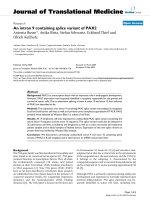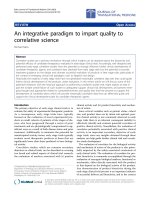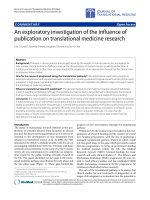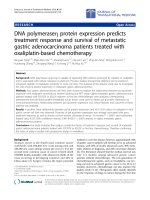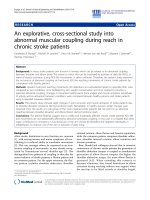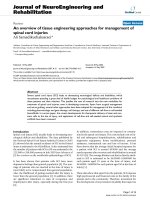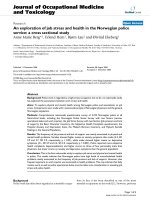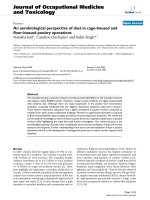Báo cáo hóa học: "An Artificial Intelligence Approach for Modeling and Prediction of Water Diffusion Inside a Carbon Nanotube'''' potx
Bạn đang xem bản rút gọn của tài liệu. Xem và tải ngay bản đầy đủ của tài liệu tại đây (225.76 KB, 5 trang )
NANO EXPRESS
An Artificial Intelligence Approach for Modeling and Prediction
of Water Diffusion Inside a Carbon Nanotube
Samad Ahadian Æ Yoshiyuki Kawazoe
Received: 30 April 2009 / Accepted: 24 May 2009 / Published online: 4 June 2009
Ó to the authors 2009
Abstract Modeling of water flow in carbon nanotubes is
still a challenge for the classic models of fluid dynamics. In
this investigation, an adaptive-network-based fuzzy infer-
ence system (ANFIS) is presented to solve this problem.
The proposed ANFIS approach can construct an input–
output mapping based on both human knowledge in the
form of fuzzy if-then rules and stipulated input–output data
pairs. Good performance of the designed ANFIS ensures its
capability as a promising tool for modeling and prediction
of fluid flow at nanoscale where the continuum models of
fluid dynamics tend to break down.
Keywords Carbon nanotube Á Water diffusion Á
Artificial intelligence Á Modeling and prediction
Introduction
Carbon nanotubes (CNTs) have drawn much attention, not
only for their exceptional mechanical and electrical prop-
erties, but also for their application in the new emerging
area of nanofluidics since they can transport fluids at an
extraordinarily fast flow rate. This property has diverse
applications, such as in charge storage devices [1], mem-
brane industry [2], drug-delivery devices [3], and under-
standing the transport processes in biological channels [4].
In the past few years, a significant number of works
have been devoted to the study of fluid flow through CNTs
[5–8]. Fast pressure-driven flow of fluids in membranes of
CNTs 1.6 and 7 nm in diameter has been measured by
Majumder et al. [5] and Holt et al. [6], respectively. They
indicated measured values of 2 to 5 orders of magnitude
larger than those calculated by the continuum-based no-slip
Hagen–Poiseuille equation. Recently, Thomas et al. [7]
have re-evaluated water transport through CNTs having
diameters ranging from 1.66 to 4.99 nm. They found that
the measured flow rates exceeded those predicted by the
no-slip Hagen–Poiseuille relation. Interestingly, new
experimental results for the flow of water, ethanol, and
decane through carbon nanopipes with relatively large
inner diameters (i.e., 43 ± 3 nm) have demonstrated that
transport is enhanced up to 45 times that of theoretical
predictions [8]. Extraordinarily fast flow rate of fluids in
nanopores other than CNTs has also been observed [9, 10].
As can be seen, the classic models of fluid dynamics start
to break down while we diminish the working length scale.
As a result, new approaches for modeling of fluid flow at
nanoscale dimensions are needed. The present work is an
attempt to introduce an alternative methodology, namely,
the fuzzy logic approach, to explain the behavior of fluids
at nanoscale. As a case study, we applied this method for
modeling and prediction of water diffusion inside a CNT
(6,6).
Modeling of phenomena based on conventional mathe-
matical tools (e.g., differential equations) is not appropriate
for dealing with ill-defined and uncertain problems. By
contrast, a fuzzy logic approach employing fuzzy if-then
rules can model the qualitative aspects of human knowl-
edge and reasoning processes without employing precise
quantitative analyses. The fuzzy modeling or fuzzy iden-
tification, first explored systematically by Takagi et al.
[11]. The aim of this paper is to suggest an architecture
called adaptive-network-based fuzzy inference system
S. Ahadian (&) Á Y. Kawazoe
Institute for Materials Research (IMR), Tohoku University,
Sendai 980-8577, Japan
e-mail: ;
123
Nanoscale Res Lett (2009) 4:1054–1058
DOI 10.1007/s11671-009-9361-3
(ANFIS) for modeling and prediction of fluid flow at
nanoscale dimensions since it has been suggested to be
universal approximator of any continuous function [12].
Furthermore, it has been shown that the obtained results by
the ANFIS approach in estimation of non-linear functions
outperform the auto-regressive models and other connec-
tionist approaches, such as neural networks [12]. ANFIS
can serve as a basis for constructing a set of fuzzy if-then
rules with appropriate membership functions to generate
the stipulated input–output pairs. This architecture was
proposed by Jang in 1991 [13, 14]. More information
regarding the architecture and the performance of ANFIS
can be found in the literature [12]. In what follows, first,
performance of an MD simulation of water diffusion
through a CNT (6,6) is described. An ANFIS technique is
then employed for modeling and prediction of this phe-
nomenon. Finally, some benefits of the designed ANFIS
are detailed.
Model and MD Simulation
To show the diffusion of water molecules in CNTs, a CNT
(6,6) (13.4 A
˚
long and 8.1 A
˚
in diameter) was solvated in a
cubic box (Box length L = 32.06 A
˚
) of 1,034 TIP3P water
molecules [15]. The MD simulation was performed using
Discover, which is a molecular modeling software package
implemented with Materials Studio 4.2 [16]. In this
investigation, the force field used to model the interatomic
interactions was the consistent-valence force field (CVFF).
The MD simulation was done at the NVT statistical
ensemble (i.e., a constant number of particles, volume and
temperature). The temperature was kept constant at 300 K
using a Nose
´
-Hoover thermostat [17, 18]. The cell multi-
pole method [19] was employed for the non-bond sum-
mation method. A time step of 2 fs was used and structures
were sampled every 1 ps. The overall time of the simula-
tion was set to be 50 ns.
Initially, the CNT was in the center of the bath of water
molecules. However, the nanotube was free and could be
displaced. During the simulation time (i.e., 50 ns), it
was observed that water molecules penetrated into the CNT
and passed through it in such a way that the CNT remained
occupied by an average of about five water molecules
during the whole period of 50 ns. During the simula-
tion time, an average of about 17 water molecules per
nanosecond entered the nanotube and left the other side. It
yields an average volumetric flow rate of about 50.4 9
10
-14
cm
3
s
-1
, which is comparable to the reported water
diffusion rate through a channel of the transmembrane
protein aquaporin-1 [20]. As a result, our MD simulation
showed good agreement with experimental results.
Results and Discussion
Now, let us define the flow rate of water molecules as the
number of water molecules entering the CNT on one side
and leaving the other side per nanosecond. Using the
simulation described earlier, the flow rate of water mole-
cules as a function of time was recorded. This correlation is
shown in Fig. 1. In the following section, the applicability
of the ANFIS approach for modeling and prediction of the
flow rate of water molecules as a function of time, which is
demonstrated in Fig. 1, is put to test. In other words, we
attempted to find the unknown function Y = F(X) with the
aid of the ANFIS approach, where Y is defined as the
values of the flow rate of water molecules and X stands for
the corresponding time values. The Fuzzy Logic Toolbox
embedded in MATLAB 7.0 [21] is used for modeling and
prediction of the flow rate of water molecules as a function
of time. The input layer of the ANFIS consists of the time
while the output layer of the ANFIS corresponds to the
flow rate. The known values of the function up to the point
Y = X are used to predict the value at some point in the
future Y = X ? P. The standard method for this type of
prediction is to create a mapping from D points of the
function spaced D apart, that is, ðYðX ÀðD À1ÞDÞ; ;
YðX ÀDÞ; YðXÞÞ, to a predicted future value Y(X ? P). To
this end, all recorded data set was divided into 6 parts. The
first 5 parts of pairs (i.e., training data set) were used for
training the ANFIS while the remaining 1 part of pairs (i.e.,
checking data set) were used for validating the identified
model. Here, the value D was selected to be 1. Therefore,
we had 4 inputs. In order to achieve an effective ANFIS, all
Fig. 1 Plot of the flow rate of water molecules through a CNT (6,6)
as a function of time resulting from the molecular dynamics (MD)
simulation
Nanoscale Res Lett (2009) 4:1054–1058 1055
123
data sets are needed to be normally preprocessed using an
appropriate transformation method. It has been reported
that the ANFIS systems trained on transformed data sets
achieve better performance and faster convergence in
general. There are many transformation procedures that can
be applied to a data set [22]. In this study, the all data sets
(i.e., training and checking data sets) were individually
transformed with the log function, which has the following
equation [23]:
z
trn
¼ a log
10
ðtrn þbÞ
z
chk
¼ a log
10
ðchk þbÞ
where z
trn
and z
chk
are the transformed values of the
training and checking data sets, a is an arbitrary constant
(Here a = 4), and b is set to 1 to avoid the entry of zero in
the log functions. The number of membership functions
assigned to each input of the ANFIS was arbitrarily set to 2,
therefore the rule number is 16. The ANFIS used here
contains a total of 104 fitting parameters, of which 24 are
premise parameters and 80 are consequent parameters.
Notice that the number of membership functions, which
was chosen to be 2 is the maximum number to obtain the
maximum performance of the designed ANFIS since we
should take care of overtraining. In a sense, the so-called
‘‘overtraining’’ term indicates that a given ANFIS adapts
itself too well to the training data set in such a way that
further improvement based on the training data set not only
impairs more accurate predictions of the checking data set
but may also have adverse effects on those predictions.
Note that in the case of overtraining, usually the total
number of fitting parameters in the ANFIS is more than the
number of pairs in the training data set. The root mean
squared error (RMSE) was used in order to assess the
accuracy of the actual output in comparison with the one
predicted by the ANFIS. Indeed, this statistical parameter
does measure the correlation between the target values
(i.e., the flow rate of water molecules resulting from the
MD simulation) and the corresponding values predicted
by the ANFIS. Note that for a perfect correlation, RMSE
should be 0. After 200 epochs, we had RMSE
trn
, and
RMSE
chk
equal zero (note that the designed ANFIS yielded
RMSE
trn
= 0.4289 ns
-1
and RMSE
chk
= 0.4840 ns
-1
.Since
these values have not a real physical meaning, they were
reported with only one significant digit). It should be noted
that the so-called ‘‘epoch’’ term means the presentation of
each data set to the ANFIS and the receipt of output values.
After 200 epochs, we obtained 200 RMSE values for both
training and checking data sets. In order to check whether
the difference between two RMSE values is significant, we
did use the t-test. As you know, the t-test assesses whether
the means of two data sets are statistically different from
each other. The result showed that with a probability more
than 95%, the difference between two RMSE values is not
significant. During repeated epochs, it was observed that
the RMSE monotonically declines for both data sets (i.e.,
training, and checking data sets). Eventually, it reaches a
value less than 0.5 after 200 epochs. The correlated func-
tion, namely, Y = F(X), using the ANFIS approach is also
showed in Fig. 1. As can be seen, the designed ANFIS has
a very good performance to depict the behavior of water
inside the CNT. In addition, since both RMSEs are very
small, we conclude that the proposed ANFIS has captured
the essential components of the underlying dynamics. In
other words, the designed ANFIS can successfully model
and predict the flow rate of water molecules through the
CNT as a function of time, which has been derived by the
MD simulation. The resulting 16 fuzzy if-then rules are
listed below.
If input1 is MF1 and input2 is MF1 and input3 is MF1
and input4 is MF1, then output = c
~
1
:Y
~
If input1 is MF1 and input2 is MF1 and input3 is MF1
and input4 is MF2, then output = c
~
2
:Y
~
If input1 is MF1 and input2 is MF1 and input3 is MF2
and input4 is MF1, then output = c
~
3
:Y
~
If input1 is MF1 and input2 is MF1 and input3 is MF2
and input4 is MF2, then output = c
~
4
:Y
~
If input1 is MF1 and input2 is MF2 and input3 is MF1
and input4 is MF1, then output = c
~
5
:Y
~
If input1 is MF1 and input2 is MF2 and input3 is MF1
and input4 is MF2, then output = c
~
6
:Y
~
If input1 is MF1 and input2 is MF2 and input3 is MF2
and input4 is MF1, then output = c
~
7
:Y
~
If input1 is MF1 and input2 is MF2 and input3 is MF2
and input4 is MF2, then output = c
~
8
:Y
~
If input1 is MF2 and input2 is MF1 and input3 is MF1
and input4 is MF1, then output = c
~
9
:Y
~
If input1 is MF2 and input2 is MF1 and input3 is MF1
and input4 is MF2, then output = c
~
10
:Y
~
If input1 is MF2 and input2 is MF1 and input3 is MF2
and input4 is MF1, then output = c
~
11
:Y
~
If input1 is MF2 and input2 is MF1 and input3 is MF2
and input4 is MF2, then output = c
~
12
:Y
~
If input1 is MF2 and input2 is MF2 and input3 is MF1
and input4 is MF1, then output = c
~
13
:Y
~
If input1 is MF2 and input2 is MF2 and input3 is MF1
and input4 is MF2, then output = c
~
14
:Y
~
If input1 is MF2 and input2 is MF2 and input3 is MF2
and input4 is MF1, then output = c
~
15
:Y
~
If input1 is MF2 and input2 is MF2 and input3 is MF2
and input4 is MF2, then output = c
~
16
:Y
~
where Y
~
¼½YðX À3Þ; YðX À 2Þ; YðX À 1Þ; Yð XÞ; 1 and
c
~
i
is the ith row of the following consequent parameter
matrix C:
1056 Nanoscale Res Lett (2009) 4:1054–1058
123
c ¼
0:047 0:1534 0:1532 0:1564 0:03197
0:04419 0:08022 0:08127 0:08678 0:01689
0:03298 0:05375 0:05621 0:05329 0:01111
0:03076 0:03841 0:04153 0:04316 0:008044
0:03429 0:06251 0:05832 0:05861 0:01225
0:02821 0:03883 0:03552 0:03957 0:00755
0:03316 0:04254 0:04285 0:03656 0:00795
0:01982 0:02382 0:02454 0:0241 0:004572
0:2703 0:298 0:2951 0:2938 0:06008
0:2943 0:2998 0:3016 0:3334 0:06233
0:2338 0:2381 0:2571 0:2303 0:04887
0:217 0:2157 0:2369 0:2465 0:04491
0:2521 0:2776 0:2485 0:2436 0:0518
0:232 0:2472 0:2185 0:2515 0:04678
0:2527 0:2831 0:2832 0:2367 0:0519
0:1445 0:1573 0:1612 0:1583 0:0299
2
6
6
6
6
6
6
6
6
6
6
6
6
6
6
6
6
6
6
6
6
6
6
6
6
6
6
4
3
7
7
7
7
7
7
7
7
7
7
7
7
7
7
7
7
7
7
7
7
7
7
7
7
7
7
5
The linguistic labels MF1
i
and MF2
i
(i = l to 4) are
defined by the bell membership function (with different
parameters a, b, and c):
l
A
ðxÞ¼
1
1 þ
xÀc
a
ÀÁ
2
hi
b
ð1Þ
Table 1 also lists the linguistic labels and the
corresponding consequent parameters in Eq. 1. Each of
these parameters has a physical meaning: c determines the
center of the membership function, a is the half width of
the membership function and b (together with a) controls
the slopes at the crossover points (where the membership
function value is 0.5). An example of the bell membership
function is showed in Fig. 2.
Indeed, in this case study, the MD simulation can
explain the observed phenomenon (i.e., the water flow
inside the CNT). However, it would be so difficult to
explain and interpret this phenomenon, if we consider other
parameters such as temperature, pressure, shape, length,
etc., as a variable parameter. In the latter case, the MD
simulation is just able to draw a picture of the phenomenon
and it is not able to tell us about the effect of each
parameter on the phenomenon, the effect of combined
parameters (e.g., pressure and temperature together), etc.
On the other hand, modeling of this phenomenon using the
ANFIS approach would provide us invaluable information
in the analysis of the process (e.g., the underlying physical
relationships among influencing parameters) and therefore
design of new applications. Therefore, this methodology
holds potential of becoming a useful tool in modeling and
predicting the behavior of molecular flows through the
CNTs (or generally nanoscale dimensions). In addition, the
proposed ANFIS has the following advantages:
1) If the human expertise is not available, we can still set
up intuitively reasonable initial membership functions
and start the learning process to generate a set of fuzzy
if-then rules to approximate a desired data set.
2) An ANFIS is able to learn and therefore generaliza-
tion. Generalization refers to the production by the
ANFIS of reasonable outputs for inputs not encoun-
tered during the training process. The generalization
ability comes from this fact that while the training
process is occurring, the checking data set is used to
assess the generalization ability of the ANFIS. As a
result, a well-designed ANFIS is capable of producing
reliable output(s) for unseen input(s). Just imagine that
the ANFIS approach could give us the reliable results
for unseen cases, which are so difficult to perform by
the computer simulations and to do by experiments.
In addition, in those cases, which we can perform
computer simulations and/or experiments, using a
designed ANFIS is much faster and easier than doing
computer simulations and/or experiments since doing
a corresponding experimental work is a difficult task
and takes much time and cost and using computer
simulations also take much time in the order of several
days with the aid of a supercomputer. However, a
designed ANFIS can be run on a normal personal
computer.
3) An ANFIS ignores a relatively large amount of noise
or variations in solving problems while it derives
Table 1 Membership functions and consequent parameters of the
designed adaptive-network-based fuzzy inference system (ANFIS)
Membership function type abc
MF1
input1
2.944 2.081 -0.08093
MF2
input1
3.087 2 6.116
MF1
input2
1.155 1.995 4.089
MF2
input2
0.946 2.01 6.23
MF1
input3
1.159 1.995 4.092
MF2
input3
0.9382 2.013 6.245
MF1
input4
1.151 1.993 4.082
MF2
input4
0.974 2.01 6.22
Fig. 2 An example of the bell membership function (Here, a = 2,
b = 4, and c = 6)
Nanoscale Res Lett (2009) 4:1054–1058 1057
123
principle rules of a given problem. Statistical errors
in reported data either from experiments or from
computer simulations can always be expected. Gener-
ally, experimentally measured values include statisti-
cal errors since by repeating an experiment the same
result is not achieved. Interestingly, such errors can
also be observed in computer simulations [24]. Since
the obtained results using computer simulations and/or
experiments bear statistical errors, we should repeat
those tasks several times to ensure the accuracy of the
results and therefore they are time and cost consuming.
As a result, a model describing a phenomenon, which
is capable of removing such undesirable errors, is
needed.
4) A designed ANFIS is able to predict the reasonable
output(s) for future unseen data sets. In other words,
the predictive ability of a designed ANFIS is not
restricted to the training data set. This property could
be an asset in modeling of fluid flow at nanoscale
dimensions since experimental reports on the dynam-
ics of fluids inside nanotubes are less abundant than
the static case. The main reason is the high comple-
xity of experimental setups to perform such experi-
ments. Therefore, available experiments have been
performed, mostly on multi-wall nanotubes. On the
other hand, a vast literature exists on computer
simulations of liquid flow, liquid molecular structure
under confinement, and interaction of liquid with the
tube walls. Computing power requirements have, thus
far, limited these findings to small single-wall nano-
tubes, creating a gap in terms of nanotube size
between experimental and simulation results [25]. As
a result, computer simulations should be extended
beyond these computational limits. This can only be
achieved with new algorithms that allow for the
coupling of different simulation methods on different
scales, both in time and space. The need to make such
extrapolations has practical applications, such as in
determination of the osmotic permeability of nano-
channels [26].
Conclusion
In summary, by employing an ANFIS approach, we suc-
ceeded to derive fuzzy if-then rules to describe the input–
output behavior of water diffusing through a nanochannel.
Some advantages of this approach over conventional
methods for modeling and prediction of this phenomenon
were mentioned. The application shown here is only the tip
of an iceberg. We hope that this tool could provide us new
insights in the field of nanofluidics where the continuum
models of fluid dynamics tend to break down.
Acknowledgments The authors sincerely appreciate the staff of the
Center for Computational Materials Science of the Institute for
Materials Research (IMR), Tohoku University, for its continuous
support of the supercomputing facilities. This work was supported
(in part) by the Japan Society for the Promotion of Science (JSPS).
References
1. D.J. Mann, M.D. Halls, Phys. Rev. Lett. 90, 195503 (2003). doi:
10.1103/PhysRevLett.90.195503
2. H. Verweij, M.C. Schillo, J. Li, Small 3, 1996 (2007). doi:
10.1002/smll.200700368
3. G. Pagona, N. Tagmatarchis, Curr. Med. Chem. 13, 1789 (2006).
doi:10.2174/092986706777452524
4. R. Wan, J. Li, H. Lu, H. Fang, J. Am. Chem. Soc. 127, 7166
(2005). doi:10.1021/ja050044d
5. M. Majumder, N. Chopra, R. Andrews, B.J. Hinds, Nature 438,
44 (2005). doi:10.1038/43844a
6. J.K. Holt, H.G. Park, Y. Wang, M. Stadermann, A.B. Artyukhin,
C.P. Grigoropoulos, A. Noy, O. Bakajin, Science 312, 1034
(2006). doi:10.1126/science.1126298
7. J.A. Thomas, A.J.H. McGaughey, Nano Lett. 8, 2788 (2008). doi:
10.1021/nl8013617
8. M. Withby, L. Cagnon, M. Thanou, N. Quirke, Nano Lett. 8,
2632 (2008). doi:10.1021/nl080705f
9. S. Joseph, N.R. Aluru, Nano Lett. 8, 452 (2008). doi:10.1021/
nl072385q
10. C.Y. Won, N.R. Aluru, J. Am. Chem. Soc. 129, 2748 (2007). doi:
10.1021/ja0687318
11. T. Takagi, M. Sugeno, IEEE. Trans. Syst. Man. Cybern. 15,
116132 (1985)
12. J S. Roger Jang, C T. Sun, E. Mizutani, Neuro-fuzzy and soft
computing: a computational approach to learning and machine
intelligence (Prentice Hall, Upper Saddle River, NJ, 1997)
13. J S. Roger Jang, in Proceedings of the Ninth National Confer-
ence on Artificial Intelligence (1991), p. 762
14. J S. Roger Jang, in Proceedings of the 4th IFSA World Congress
(1991), p. 82
15. W.L. Jorgensen, J. Chandrasekhar, J.D. Madura, R.W. Impey,
M.L. Klein, J. Chem. Phys. 79, 926 (1983). doi:10.1063/1.445869
16. Accelrys Software Inc., San Diego, CA, USA, (2007)
17. S. Nose
´
, J. Chem. Phys. 81, 511 (1984). doi:10.1063/1.447334
18. W.G. Hoover, Phys. Rev. A. 34, 2499 (1986). doi:10.1103/Phys
RevA.34.2499
19. J. Zheng, R. Balasundaram, S.H. Gehrke, G.S. Heffelfinger, W.A.
Goddard III, S. Jiang, J. Chem. Phys. 118, 5347 (2003). doi:
10.1063/1.1553979
20. M.L. Zeidel, S.V. Ambudkar, B.L. Smith, P. Agre, Biochemistry
31, 7436 (1992). doi:10.1021/bi00148a002
21. Fuzzy Logic Toolbox user’s guide, version 2, The MathWorks
Inc., (2006)
22. J.D. Salas, Analysis and modeling of hydrologic time series, in
Handbook of hydrology, ed. by D.R. Maidment (McGraw-Hill,
New York, 1993)
23. M. Aqil, I. Kita, A. Yano, S. Nishiyama, J. Hydrol. (Amst) 337,
22 (2007). doi:10.1016/j.jhydrol.2007.01.013
24. D. Frenkel, B. Smit, Understanding molecular simulation: from
algorithms to applications (Academic Press, London, 2002)
25. D. Mattia, Y. Gogotsi, Microfluid. Nanofluid. 5, 289 (2008). doi:
10.1007/s10404-008-0293-5
26. F. Zhu, E. Tajkhorshid, K. Schulten, Phys. Rev. Lett. 93, 224501
(2004). doi:10.1103/PhysRevLett.93.224501
1058 Nanoscale Res Lett (2009) 4:1054–1058
123
